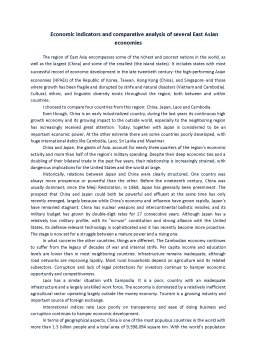Extras din referat
The region of East Asia encompasses some of the richest and poorest nations in the world, as well as the largest (China) and some of the smallest (the island states). It includes states with most successful record of economic development in the late twentieth century–the high-performing Asian economies (HPAEs) of the Republic of Korea, Taiwan, Hong Kong (China), and Singapore–and those where growth has been fragile and disrupted by strife and natural disasters (Vietnam and Cambodia). Cultural, ethnic, and linguistic diversity exists throughout the region, both between and within countries.
I choosed to compare four countries from this region: China, Japan, Laos and Cambodia.
Even though, China is an early industrialized country, during the last years its continuous high growth economy and its growing impact to the outside world, especially to the neighboring region has increasingly received great attention. Today, together with Japan is considerred to be an important economic power. At the other extreme there are some countries poorly developed, with huge international debts like Cambodia, Laos, Sri Lanka and Myanmar.
China and Japan, the giants of Asia, account for nearly three quarters of the region’s economic activity and more than half of the region’s military spending. Despite their deep economic ties and a doubling of their bilateral trade in the past five years, their relationship is increasingly strained, with dangerous implications for the United States and the world at large.
Historically, relations between Japan and China were clearly structured. One country was always more prosperous or powerful than the other. Before the nineteenth century, China was usually dominant; since the Meiji Restoration, in 1868, Japan has generally been preeminent. The prospect that China and Japan could both be powerful and affluent at the same time has only recently emerged, largely because while China’s economy and influence have grown rapidly, Japan’s have remained stagnant. China has nuclear weapons and intercontinental ballistic missiles, and its military budget has grown by double-digit rates for 17 consecutive years. Although Japan has a relatively low military profile, with its ”no-war” constitution and strong alliance with the United States, its defense-relevant technology is sophisticated and it has recently become more proactive. The stage is now set for a struggle between a mature power and a rising one.
In what concerns the other countries, things are different. The Cambodian economy continues to suffer from the legacy of decades of war and internal strife. Per capita income and education levels are lower than in most neighboring countries. Infrastructure remains inadequate, although road networks are improving rapidly. Most rural households depend on agriculture and its related subsectors. Corruption and lack of legal protections for investors continue to hamper economic opportunity and competitiveness.
Laos has a similar situation with Campodia. It is a poor, country with an inadequate infrastructure and a largely unskilled work force. The economy is dominated by a relatively inefficient agricultural sector operating largely outside the money economy. Tourism is a growing industry and important source of foreign exchange.
International indices rate Laos poorly on transparency and ease of doing business and corruption continues to hamper economic development.
In terms of geographical aspects, China is one of the most populous countries in the world with more than 1.3 billion people and a total area of 9,598,094 square km. With the world’s population currently at aprox 6.6 billion people China makes up 20% of the worlds population and it’s the third world largest country. With this huge population China must find ways to sustain their natural resources in order to maintain all of these people. China’s population is expected to peek in 2030. One of the most important natural resources China is seeing being depleted do to overpopulation is water. The more people a country has the more industrial needs, agricultural needs and consumption needs arise. This means that the amount of water in China needs to increase to meet demand. Instead the water is being depleted and could hit the danger zone by 2030. The other major natural resource that has been depleted is the forests. Right now China only has 3-4% of the world's forest area. This creates major environmental problems such as soil erosion and land desertification. There also becomes an increased occurrence of natural disasters such as drought, high winds, and floods. All of these problems are directly linked to the lack of the forest and the uneven way it is currently distributed.
Preview document
Conținut arhivă zip
- Comparative Analysis of Several East Asian Economies.docx







